Sharing the Light: Sacred Values + Design Thinking
March 28, 2018 at 4:40 PM
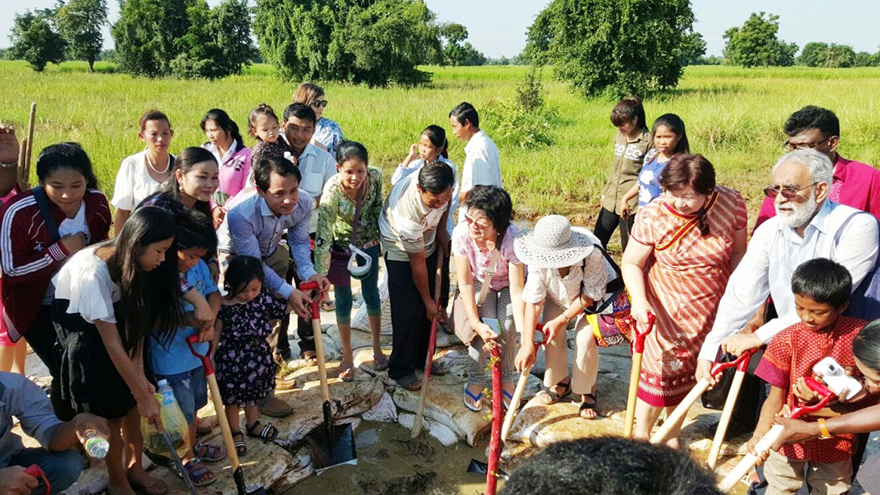
Walk In, Look Up
White steps glitter in the cold air.
As you climb, you glance up.
A temple arcs over you, inviting you to pass beneath the words: Thy heart is My home...
You walk through glass doors into a small, warm alcove, then through a second set of doors, into the sanctuary.
The inner space is creamy white, with three tiers of windows overlooking Lake Michigan and surrounding neighborhoods. Perforations in the concrete fabric create a dappled, ever-changing glow.
You breathe in the light: rich, silky, polished smooth by thousands and thousands of prayers.
You look up�and catch your breath.
The dome is lace-cut, like a delicate paper snowflake, held up to the sky.
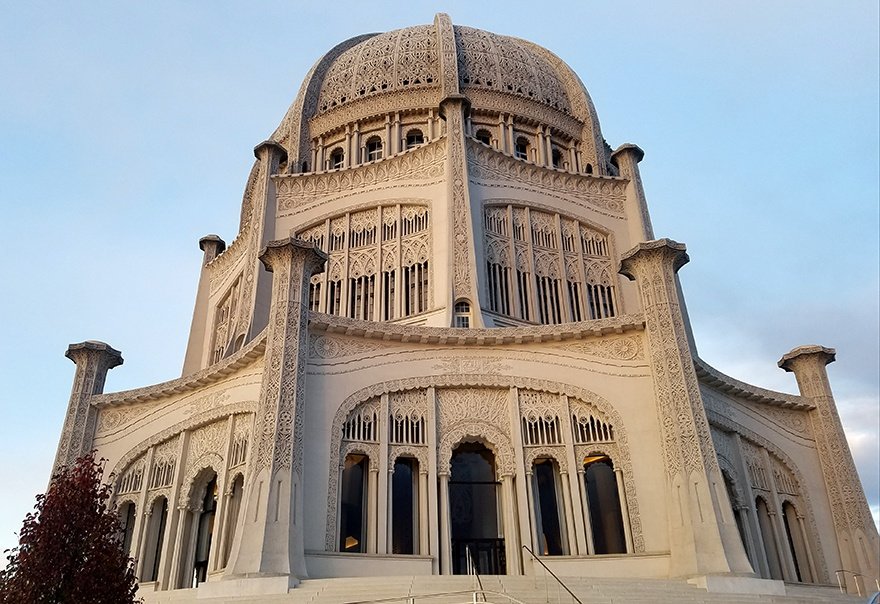
The Baha'i House of Worship on the evening the NeigerDesign team visited
The Baha'i House of Worship, located on Chicago's North Shore, is a space to catch up with yourself, to pray, reconnect, be. The inner quiet is broken only by a few whispers and the hushing of the HVAC system (which is old�the Temple opened to the public in 1953).
To capture, in graphics, its light-play and structural beauty, would be quite a task. Yet that is why Carol Neiger was invited to the Temple: to help redesign and redefine its public identity.
It was near sunset on a November day when Carol and her team arrived. We went inside the Temple together. She pulled out her black sketchbook and began drawing the geometric swirls that form the dome. Jim Hutchison sat in one of the rose-velvet chairs and gazed upwards, into the dome's eye, where the Greatest Name ("O Glory of the All-Glorious") is inscribed in black calligraphy against a subtle gold glow.
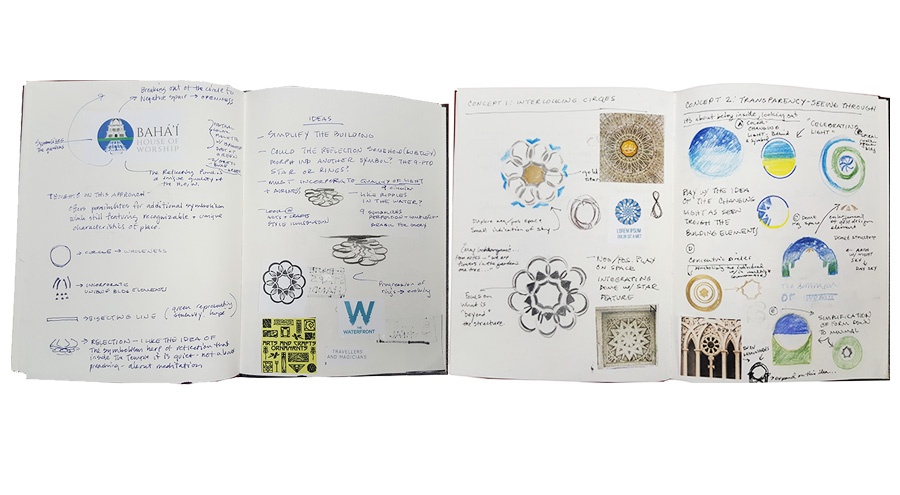
Sketchbook pages of NeigerDesign logo concepts
Woven into the quartz-concrete are symbols of many religions, as well as organic patterns (interlocking spheres, ellipses) that reflect Nature: the movement of the stars and planets, the growth of vines, the play of light through trees. Step outside, and real gardens surround the Temple on all sides�a perfect harmony of inner and outer worlds.
Sacred Values + Design Thinking
When Carol first met with us, sitting in the bookshop of the Welcome Center, another white, light-filled space, surrounded by books, I was struck by the fact that even her business cards invite wonder and curiosity.
"Hold it up to the light," Carol encouraged. Her logo, like the dome of the Temple, is perforated. This is an artist's philosophy: Look deeper, look beyond.
This approach resonated. So in fall 2016, NeigerDesign, Temple staff, and the Baha'i Office of Communications launched a creative partnership that is ongoing. We focused on how to align institutional mission, brand strategy, and public awareness. In other words, how can the Temple's purpose�to unify people around spirit and service�be shared through design thinking?
"Design thinking" describes the methods and mindset that Carol and her team employ. The process involves empathy, shared inspiration, and a continual refinement of concepts until a solution emerges. In Carol's words:
We begin with a well-researched foundation, add an intelligent and free-flowing ideation process and enhance it with a healthy dose of emotion�the perfect formula for a relevant and expressive brand. The best identities emerge from a process which is both investigative and intuitive."
The challenge? An outdated look to Temple graphics and promotional materials that didn't feel elegant or relevant. Joyce Litoff, Communications Officer for the Baha'is of the United States, explains:
"There were several variations of two old logo designs in use, one dating back to the late 1990s and the other even earlier. They both looked old and tired...We felt that neither design reflected the beauty and dignity of the Temple.
"We appreciated that NeigerDesign's approach was to first understand what the building represented: unity, warmth, welcome, inclusiveness, spirit, journey."
The Temple's Director, Christopher Vodden, agrees:
"It is important to have attractive and meaningful materials available for visitors because we want our guests to come away with a favorable and accurate impression about what the Baha'i Faith is and what the Temple stands for."
North America's Temple is the world's oldest and most sacred. Abdu'l-Baha, son of the Founder of the Baha'i Faith, laid the cornerstone here in 1912. For such a grand structure, North America's Temple has very humble origins:
"The winter blanket foregone in India; the pennies from a handkerchief sold in Persia; the dimes and nickels from [African Americans] in the South..."
According to Temple historian Bruce Whitmore, these material sacrifices eventually built the Temple, penny by penny�a project that took 50 years, spanning two World Wars and the Great Depression.
At the same time, the Temple is a place of ongoing change and excitement. A new Welcome Center opened in 2015. New staff were hired from across the country, leading to new public programs and collaborations with the Chicago Botanic Gardens, Faith in Place, the Mitchell Museum of the American Indian, the Illinois Institute of Technology, and many other NGOs, artists, scientists, and educators. How to convey these new developments�graphically?

Attendees at an event in the Baha'i Welcome Center in Wilmette
During a series of brainstorm sessions, various ideas and themes emerged. Temple staff wanted our logo to express welcome, beauty, light, and renewal. We wanted a sacred dimension, without being heavy-handed (Baha'is don't proselytize). We wanted to distinguish the Temple from other places of worship, while underscoring the deep unity that connects all people and religions.
Oneness is the essence of the Baha'i Faith: One God, one unfolding religion, one human family. Instead of viewing religions as competing pathways to the Divine, Baha'is see all faiths as sharing a common Source and trajectory�toward global justice and peace.
Other principles of the Baha'i Faith include:
- The independent search for truth
- Love as the cause of being
- The noble and eternal nature of the human soul
- The end of all prejudice
- Equality and interconnectedness of all people
- Women's advancement and gender equity
- Justice as the foundation for world peace
- Planetary wellbeing through sustainable practices
- A balanced economy; eliminating extreme wealth and poverty
- The harmony of science and religion
- The power of consultation and open communication
- Political non-partisanship
- Universal participation in the wellbeing of our communities
- Joyful service to each other
Baha'i temples have nine sides and nine entrances�one for each of the nine major world religions. They are a refuge for everyone, regardless of race, class, faith (or lack thereof). Their purpose is both prayer and service to humanity. A cluster of social, educational, scientific, and humanitarian agencies will eventually surround every Baha'i Temple offering practical support and knowledge to all members of the community.
There are eight continental Baha'i Houses of Worship. The newest opened in 2016 near Santiago, Chile. National temples are also envisioned, the first in the Democratic Republic of Congo and Papua New Guinea. Five local temples are currently being constructed: in India, Kenya, Colombia, and Vanuatu. The first of these just opened in Battambang, Cambodia.
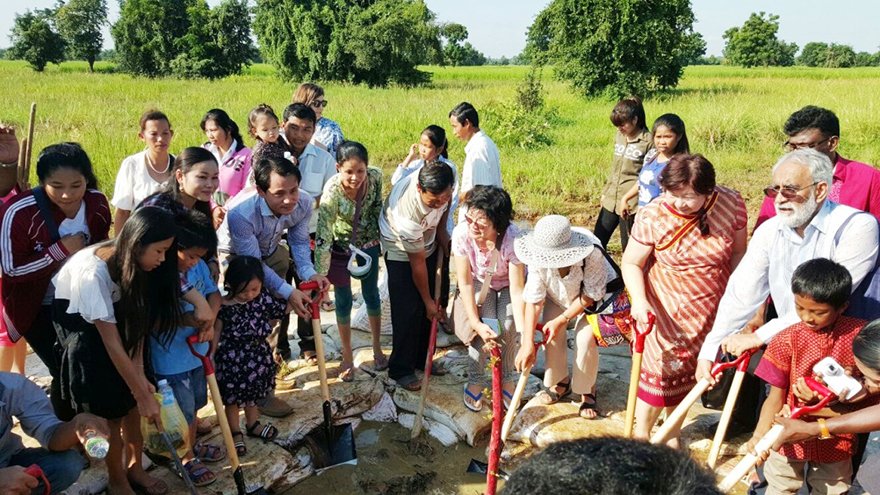
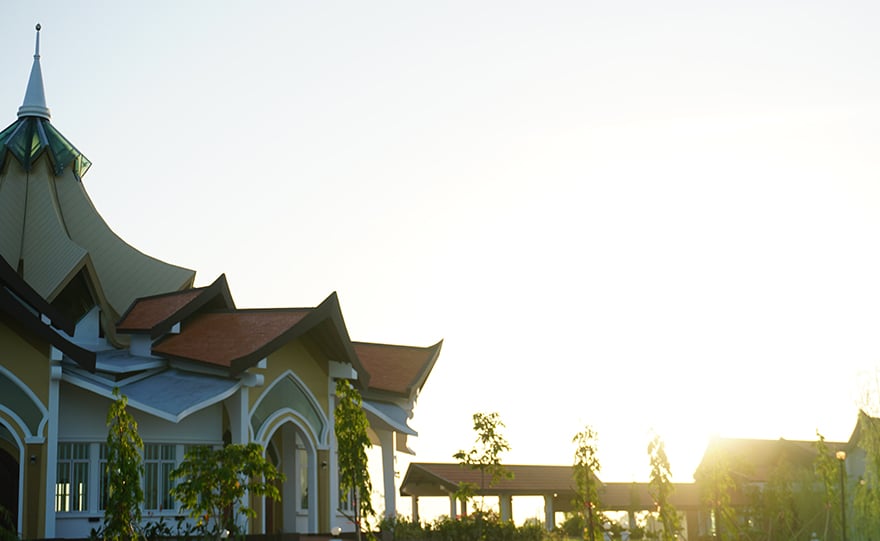
Images of the ground-breaking ceremony and finished construction of the local temple in Cambodia
An Idea Dawns
The Temple's sacred values, complex architecture, and natural beauty presented Carol's team with a challenge: How to distill so many dimensions into a 2D logo design?
In December 2016, the NeigerDesign team offered us eight unique concepts, many based on the inner dome�an organic web of light and form. Floral and spiral shapes were explored, to illustrate unity, spiritual growth, and inclusion.
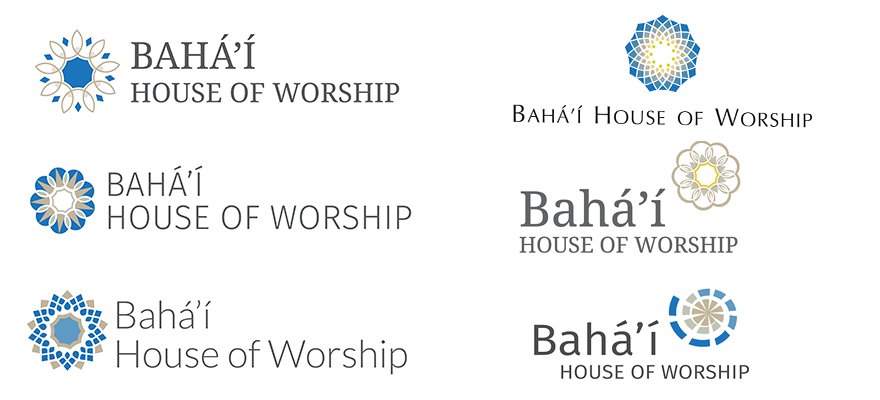
Logo concepts by NeigerDesign
The House of Worship team was excited, but no firm consensus emerged. What should we do? Go back to the drawing board?
Joyce remembers:
"[The team] initially presented several abstract designs that attempted to convey these intangibles. None of these designs were quite able to capture the concepts the way the actual building does. So NeigerDesign shifted gears to make another attempt at including some elements of the building's iconic architecture while avoiding creating a mere illustration."
Joyce, Carol and I consulted, exploring different approaches to the logo. We asked:
- How can we prevent the design from looking too cartoonish and flat?
- What about showing only a portion of the Temple, rather than the whole outline?
- How will the logo appear if it is reduced for various purposes?
- How will the logo translate into a monochromatic color scheme?
- What colors best express the ever-changing light of the Temple?
Over the phone one day, Joyce and I spoke. For inspiration, we returned to the original Arabic name for the Baha'i Temple: Mashriqu'l-Adhkar, Dawning Place for the Mention of God.
The idea of the sunrise�the dawning place�became a central concept to be graphically communicated. NeigerDesign skillfully brought together the palette of this dawning place with simplified architectural lines suggesting the dome, windows and columns. They added fonts that were similar to those found in the new Welcome Center. The result is a unified, beautiful, modern logo."
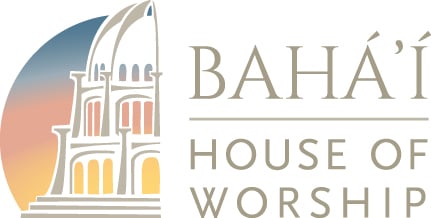
Finalized logo for the Baha'i House of Worship by NeigerDesign
The House of Worship is a place of dawn light and new energy. It connects us to our breath, heartbeat, and shared human hopes. When you come here, you feel refreshed, like waking from a delicious night's sleep.
Once, while I was working at the Welcome Center, a priest and several nuns came to visit. "There's a peacefulness here, in the temple and gardens," said the priest. One of the nuns hugged me. I could feel the peace inside her�in her bright, generous smile and the kindness of her touch.
When Carol showed us the next round of designs, everyone nodded. Yes. That's it. It was easy to pinpoint the winning logo. The colors rise from gold to rose to blue. The Temple (only half-shown) is a catchment for the light, which soaks through its open windows and doors.
Light of Unity
Speaking of light, this element also formed the basis for NeigerDesign's next project undertaken for the Baha'is, designing the brand identity for a national festival called Light of Unity.
The purpose of the Festival was to celebrate the 200th anniversary of the birth of Baha'u'llah, Founder of the Baha'i Faith. Baha'u'llah is the latest in the line of Messengers, which includes Moses, Jesus, and Muhammad, all descended from Abraham. Baha'u'llah was born in the Persian Empire in 1817.
These days, you will find Baha'is in practically every country and territory on earth. The range of activities planned for the 2017 Bicentenary was astonishing, including human rights campaigns, indigenous dance, music creation, education, and the visual arts.
Expectations were high for a gorgeous Bicentenary festival at the Baha'i Temple. A task force was appointed to create nine weeks of programming, spanning the arts, culture, racial justice, gender equity, human rights, youth activism, and the healing of soul and planet.
The intention of these programs was to fan sparks of a new vision in the minds and hearts of Americans. Politics and the media so often fuel mistrust, miscommunication and conflict. Let's refocus our energies: What brings us together?
When Sparks Catch Fire
Again, Temple staff presented Carol and her team with no easy task. Their job? To brand a completely new event (the Light of Unity Festival), and to convey the essence of the world's newest religion.
Ideas flew around the room. The Festival centered on spiritual renewal, hope made real. How to capture these concepts visually?
Jonathan Amen, NeigerDesign's Associate Creative Director recalls:
"With so many essential themes that we really wanted to explore, it provided a broad range of concepts for consideration. From modern representations of the 9-point star, a convergence and unity of elements, to a focus on the 200 years of the Bicentenary. In this instance, the team was really able to identify and gravitate to the solution which fully embodied the character of the celebration."
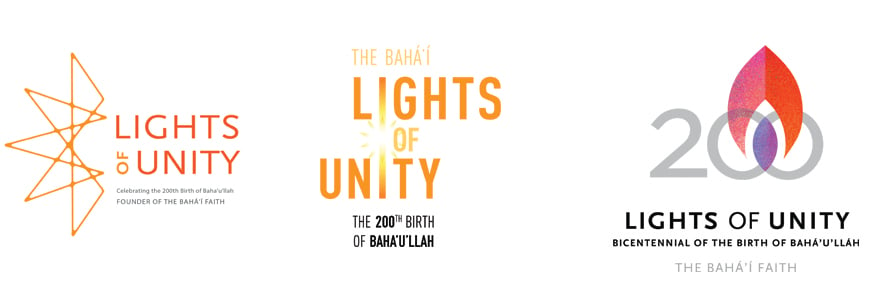
Logo concepts by NeigerDesign
With NeigerDesign's collaborative eye for design and brand strategy, the theme of light caught fire�with a double flame logo, representing two Messengers who have spurred global soul-searching. The Báb is the other divine Teacher. His title means "The Gate" and he was born in Persia, in 1819. The Báb foretold Baha'u'llah's mission�as the revealer of God's Word for this day.
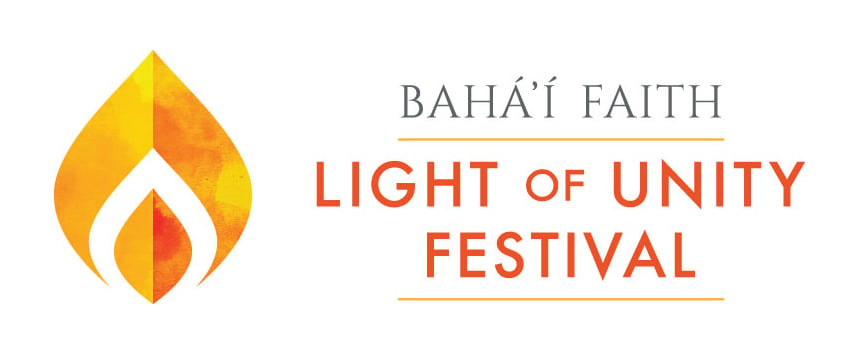
Finalized logo for the Light of Unity Festival by NeigerDesign
Justice and peace formed the main focus of the Festival, from the hard work of inner peace to the global impact of women's education, youth voices, race unity, and indigenous knowledge. For example:
- Master artist Kevin Locke shared Lakota practices of dance and interconnectedness.
- Actor and activist Rainn Wilson drew crowds of students at the University of Illinois, Chicago, to workshop solutions to injustice through art, poetry, writing, soul and self-knowledge.
- Layli Miller-Muro, founder of the Tahirih Justice Center, spoke movingly about global citizenship and the freedom of women and girls.
- Joy DeGruy educated audiences about "post-traumatic slave syndrome" and the remedies we can effect by personal and community efforts.
Rebecca Rice, a Welcome Center Coordinator and one of the key strategists for Light of Unity Festival, recalls the impact of NeigerDesign's promotional materials�including the twin-flame logo, commemorative program, and new displays for the Welcome Center:
"[The final products] contributed to messaging to the public that this House of Worship represents and embodies something everyone may wish to pay attention to and learn about...a stirring of the mind and soul [towards] beauty, grace, light, unity, creativity and diversity...
"I observed that NeigerDesign took great care and time to explore these qualities or themes when conceptualizing and then creating the Light of Unity promotional materials."
Over 8,000 people participated in the Light of Unity Festival. The result of all these efforts has been to raise the profile of the Temple, changing public perceptions and increasing participation.The Baha'i Temple is not only a tourist attraction and architectural novelty. It is not only one of the "Wonders" of North America. It is a Dawning Place�a source of creativity, diverse community, and joy.
Inner Faith and Public Face
What lessons can we draw from this creative partnership between NeigerDesign and the Baha'i House of Worship?
Carol and her team of designers understood the unifying nature of the Baha'i Faith and its houses of worship. They created designs that are timeless expressions of a new light. In her words:
How do you create a compelling and long-lasting brand? Understand the personality of the brand and its relationship with its stakeholders with thorough research before putting pencil to sketchbook. Then, align the research with both the heritage and the vision. This is the only way to create a brand that is an authentic expression of an organization."
Faith is so personal and means something different to everyone. How can you "brand" and raise awareness about a place of worship? It's a delicate balance, and one that could easily go wrong. Religion is not something to be marketed. It is a dimension of life that can only be offered�shared without an agenda, and with purity of heart.
Instead of telling the viewer what to think or feel, NeigerDesign created a brand family that invites questioning and wonderment.
What does a double flame mean to you?
What does a house, open to morning light, stir inside you?
Andréana Lefton is a writer and educator. She has lived and worked in the U.S., UK, Europe, and the Middle East�always on the lookout for hidden beauty and unheard voices. Explore more of her essays.
Comments
Questions or comments? Join the conversation!